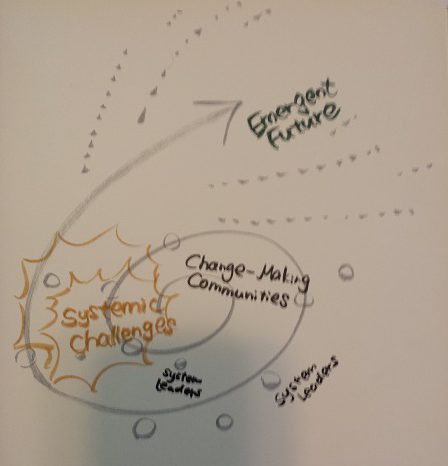Change-Making Communities™
Why Change-Making Communities?
We believe that Change-Making Communities is the most resilient approach to confronting complex systemic challenges and making the world a better place.
It is impossible to eliminate all of the complex societal issues that exist today. Dealing with systemic challenges is even more difficult.
In systemic challenges, the causes and effects of problems intertwine, various affiliated persons exist, and there are time lags between the effects of an action/non-action. However, due to the lack of time, symptomatic solutions are often adopted, which makes it more difficult to solve the problems from their roots. (Peter Senge, 2015 *1)
In these situations, we cannot solve problems merely by solutions that are planned beforehand; instead, we must find a solution as we solve the problem. Furthermore, nurturing a number of individual change-makers is not enough. The community and the people who gather must have the capacity to make changes collectively.
Thus, WIT’s vision is to create a world in which “Change-Make Communities are built and reproduced all over the world.”
That is:
• A world in which resilient communities, those that can make changes by themselves when faced with challenges, are reproduced like an ameba;
• A world in which people can share their perspectives in order to make a change; and
• A world where the people who make the change and the people who are affected by the change are not completely the opposite.
(As I am writing this, I think these explanations must be revisited and re-articulated…)
In order to make a Change-Making Community, we must find potentials within ourselves or adopt potentials from outside.
For example, we can seek out the potential in Tohoku, and the world can engage with Tohoku.
This vision is demonstrated in WIT’s name. Normally, we would say “Tohoku in the world”, but we purposely changed the order of words to “World in Tohoku.”
Change-Making Communities and Systems Leadership
It is easy to say that anyone can have the passion to make a change and engage with real-life problems. In reality, some people may be more inclined to be risk averse.
In order to build Change-Making Communities, we must have a number of people who can influence others to have the passion. As Peter Senge and others say, we must have system leaders (*2) who can help people learn from each other and make a step towards change.

WIT uses the words “Social Entrepreneurs/Organizations” and “Global Citizens” as the stakeholder groups that serve as the catalyst for change.
We value the social entrepreneurs that we work with not only for their ability to give a helping hand to those in need, but also for their ability to enable the society, its resources, its people, and the stakeholders.
A global citizen is one who can overcome the barrier of regions and sectors, can feel engaged, and can maximize his/her social return. Social return is a sense of having made a good change in the society.
WIT hopes to grow together as system leaders along with social entrepreneurs and global citizens like you!
*1: Peter Senge, Hal Hamilton, & John Kania, The Dawn of System Leadership, Stanford Social Innovation Review, Winter 2015
*2: See also Change Agent’s article (Japanese) “What is System Leaders?”
Author: Mio Yamamoto
Translater: Risa Komatsu, WIT intern, and Yuri Hongo, WIT Program Coordinator
